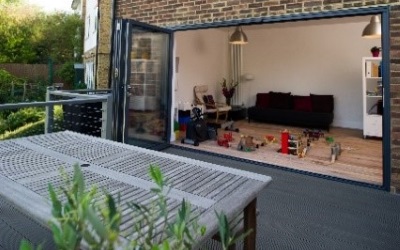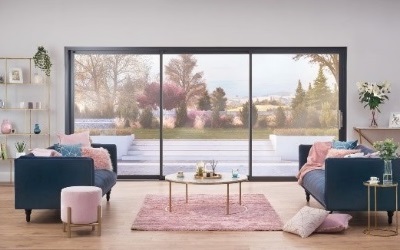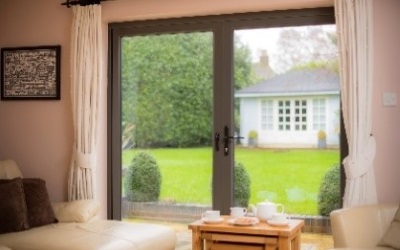Call for help and advice
T: 941-484-4861
E: info@origindw.com
< Advice Centre
You are using an outdated browser. Please upgrade your browser to improve your experience.
JavaScript seems to be disabled in your browser. You must have JavaScript enabled in your browser to utilize the functionality of this website.
skip to main contentMost homeowners install bi-fold doors between their kitchen or dining room and an outdoor space such as a patio, garden or pool. Some use interior doors to separate one indoor living space from another.
As there are a few things to consider before incorporating bi-fold doors into these parts of your home, we’ve put together a quick guide to cover them all.
Click a link below to jump to the relevant section:
The purpose of any set of patio doors is to:
And they must do this while:
Generally, there are three types of patio doors.
|
Bi-fold doors |
Sliding doors |
French doors |
|---|---|---|
 |
 |
 |
|
Doors that fold off to the side to create a wide opening |
Doors with framed panes, one or two of which slides behind the other |
Doors that swing open, usually outwards |
All three door systems have their pros and cons and each is more suitable for certain scenarios.
Read on for a summary of how bi-folds, sliding doors and French doors compare. For a more in-depth comparison, click here.
Bi-fold doors vs sliding doors vs French doors
|
Feature |
Comparison |
|---|---|
|
|
|
|
|
|
|
|
|
|
|
|
|
|
|
Kitchens are popular locations for large glass doors. Homeowners use them as:
As with patio doors, you have three choices:
|
Bi-fold doors |
Sliding doors |
French doors |
|---|---|---|
 |
 |
 |
|
Doors that fold off to the side to create a wide opening |
Doors with framed panes, one of which slides behind the other |
Doors that swing open, usually outwards |
If you’re wanting to seamlessly link two spaces, like a kitchen and an outside area, bi-fold doors are your best option.
This is because they leave a larger opening than other doors due to the manner in which they fold and stack to the side, out of the way.
Sliding doors are an alternative, but because the sliding panel moves behind or in front of the fixed panel, half of the doorway will be obstructed, or one-third if you’re using a three-pane sliding door.
French doors offer another option if you’re installing internal doors but are only really suitable for narrow openings. They can’t be used to replace an entire wall.
A high-quality set of folding glass doors can be the perfect finishing touch to any home remodeling project. Many homeowners incorporate them into their remodeling so they can enjoy the many advantages of open-plan living and alfresco dining.
When it comes to a home remodeling project, again we recommend going with either bi-fold doors, sliding doors or French doors:
|
Bi-fold doors |
Sliding doors |
French doors |
|---|---|---|
 |
 |
 |
|
Doors that fold off to the side to create a wide opening |
Doors with framed panes, one of which slides behind the other |
Doors that swing open, usually outwards |
It really depends on the opening and how you’ll use the doors.
Bi-fold doors are commonly used when remodeling, as they have the huge benefit of making rooms feel much more spacious. Even when the doors are closed, the tall and wide glass panels give the impression of the interior and exterior being one large, open space.
If you have a small kitchen, bi-fold doors will let in lots of natural light and enhance the space as a result. Combined with a tall ceiling and/or skylight, they can totally transform a small room.
Sliding doors can be better for very large openings as they provide a better view and are simpler to operate—there’s no need for you to open up a number of different panels.
French doors are a good alternative as they provide similar advantages to bi-folds.
To read more about what to consider when choosing between bi-folds, sliding doors and French doors, click here.
Whatever type of door you favor, your budget will heavily influence your decision. As a result, you need to know what you’ll pay for your chosen doors, and what factors into the overall cost of the product.
|
2-door set, vinyl: |
2-door set, aluminium: |
|
2-door set, vinyl: |
|
|
2-door set, vinyl: |
2-door set, aluminium: |
The price of doors depends on a number of things:
You can buy bi-fold doors, sliding doors and French doors in aluminum, vinyl or wood. Each material has its benefits and drawbacks:
Read more about how aluminum, vinyl and wood compare here
Although there are cheap products you can buy off the shelf, good-quality bi-folds, sliding doors and French doors are usually made to measure.
As a result, they are priced according to size and configuration, meaning the more you increase the height and width—and, with bi-folds, the number of individual door panels (leaves) you specify—the more expensive the cost.
This is simply because more materials are needed to make the doors and the manufacturing process is lengthier or more complicated.
Read more about door size and configuration here
All three types of doors contain large panes of glass by design. However, you’ll have the option of choosing between double glazing or triple glazing, and upgrading to toughened safety glass, noise reduction glass or low-emissivity glass (glass with an energy efficient coating).
Obviously, the cost increases whenever you add extra panes—as with triple glazing—or specify any upgrades.
Nowadays, most high-quality patio doors—whether bi-folds, sliding doors or French doors—come in a wide range of colors and finishes, including wood grain.
Aluminum doors are often powder-coated, using a painting process for which there are hundreds of different shades and tones. Vinyl doors were once restricted to white, but are now available in a variety of colors. Wood doors can be painted however you want.
Custom colors and finishes usually come with an extra cost, so bear that in mind when budgeting.
Read more about door colors here
How much you pay to have patio doors installed will depend on the installer and across different states and parts of the country. High-quality doors fitted by fully trained installers generally cost more. If the installation is complicated, the price will likely reflect this too.
The size and weight of the doors can affect the price. With very large and heavy doors, the installer might have to hire special lifting equipment to be able to fit them. They will charge you accordingly.